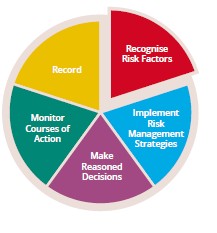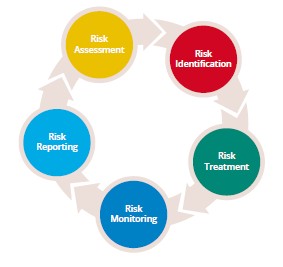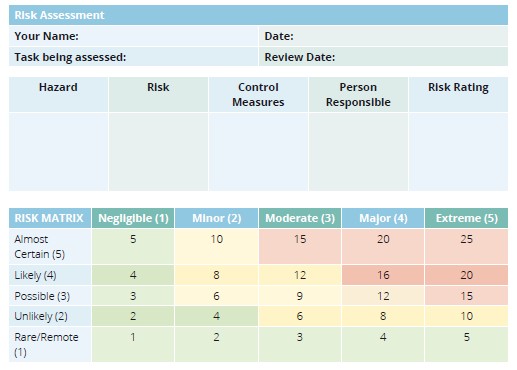Chapter 50 – Claire Barry (D3SOP10)
Domain 3 Standard of Proficiency 10
Be able to recognise important risk factors and implement risk management strategies: be able to make reasoned decisions and/or provide guidance to others to initiate, continue, modify or cease interventions, techniques or courses of action and record decisions and concerns.
|
KEY TERMS Risk factors Risk management strategies Reasoned decisions Recording
|
Social care is … providing calm and considered interventions to support people. |
TASK 1
Reflecting On Practice
As a social care worker (or a student in training), think of a time you supported another person to make a decision that involved an element of risk. How did you weigh up the benefits versus the risk? How did you support that person?
Introduction
Risk factors and risk management strategies are different in different care settings. This chapter is based on my experience as the manager of a day centre providing services to adults who have an intellectual disability.
Risk and risk management is an integral part of our work in human services. Good risk management enables the professional to support the individual, maximise their independence/opportunities whilst ensuring we are providing support to minimise risks. This can be a balancing act and the more complex the risk, the more delicate the balance. Risk can sometimes be subjective, so we benefit from having objective means to measure and evaluate risk. The risk management system supports us in this process.
Consider This
‘Risk management … includes a broad range of responses that are often closely linked to the wider process of care planning. The activities may involve preventative, responsive and supportive measures to promote the potential benefits of taking appropriate risks and to reduce the potential negative consequences of risk’ (HIQA 2014).

This chapter will use a case study to lead the student through the process of risk management.
To meet this proficiency, the skills of recognising risks, implementing a risk management strategy, making reasoned decisions and recording them is required. These steps are outlined in the diagram on the right. This chapter review these areas, after first discussing positive risk management.
Risk Management
Risk management strategies are all the strategies in place to manage risk. Ultimately, our aim is the best possible outcome for service users. Risk management should not be seen as an additional task outside the remit of a social care worker. Rather, it should be integral to our work. The Health Information and Quality Authority (HIQA), which assesses residential services for adults with an intellectual disability, has published a risk management guidance document to support organisations in their management of risk. This document proposes that managing risk should be seen as a cycle:
’The process of risk management involves a cycle of identifying risks (risks may be identified from complaints logs, individual risk assessments, incident reporting systems and observation), evaluating their potential consequences and determining the most effective methods of responding to them (i.e., of reducing the chances of them occurring and reducing the impactif they do occur). The cycle is completed by a system of regular monitoring and reporting’ (HIQA 2014).

There are several strategies at each stage of this cycle to support the process of risk management. Some of these are specific to risk and managing safety; others are part of our everyday work with the aim of building and delivering high-quality services.
The importance of this proficiency is reflected in New Directions, the policy framework that guides the provision of HSE-funded day services. Services assess their competency against a number of themes. Theme 3.1.3 states that day services should ensure that:
‘Risk assessment and management policies and procedures are in place which enable staff to support people to manage situations where they may be vulnerable. The approach to risk management supports responsible risk taking and informed decision making, as a means to enhancing the quality of life, competence, social skills and independence of people using the service’ (HSE 2014).
Positive Risk-Taking
Risk management is intrinsically linked to quality. If we have a good-quality service where the person and their needs are at the centre of what we do, then we naturally support the person with risk-taking in line with their needs and preferences.
‘HIQA acknowledges that promoting autonomy, and improving quality of life, may sometimes require a degree of risk. People who use health and social care services are entitled to the dignity and personal development associated with risk-taking. A positive approach to risk assessment acknowledges that risk-taking is part of a fulfilled life.
Positive risk assessment considers possible harms, and focuses on individual strengths and collaborating with people to meet their individual needs. HIQA supports positive riskassessment in appropriate settings when person-centred planning and associated necessary safeguards are in place’ (HIQA 2014).
Positive risk-taking or positive risk enablement is central to our work. We need to ensure that we are not overly protecting people. It can be very easy to fall into the habit of wrapping people in cotton wool. Part of the social care worker’s role is to educate, inform, and advise those we work with. However, sometimes we can over-manage risk and try to eliminate it completely. As social care workers, we need to ensure that we give people the opportunity to make their own decisions. Sometimes they may not be the decisions we would choose. It is okay for people to fail and learn from mistakes. This process in turn helps the individual be more informed and be able to make better decisions in the future. This is extremely skilled work. Informed decision-making is very different from abandoning people to their choices. People need to be supported through the process. Social care workers should strive to ensure that each individual is engaging in informed decision-making. Sometimes it can be safer or easier to be risk-adverse and not take any risks at all. However, this does not allow for personal growth of the individual or skills/competency development of the staff. Ultimately, positive risk-taking focuses on the benefits to the service user of engaging in the risk. The potential loss to their quality of life is identified and prioritised.
‘Positive risk management; persons with disabilities are afforded the “dignity of risk”. A step by step approach enables the person to gradually build the skills necessary to take part in different tasks, activities and experiences’ (Gadd & Cronin 2018).
Further suggested research into Positive Risk Taking:
- New Directions Interim Standards (HSE 2014)
- Assisted Decision-Making (Capacity) Act (2015)
- Research the ‘dignity of risk’
- Supporting People’s Autonomy: A Guidance Document (HIQA 2016)
TASK 2
You are key worker to Stephen, a 55-year-old gentleman with Down Syndrome. Stephen walks home after attending the day centre every day. On his way home he calls into the local shop, pops into his sister’s house and meets various neighbours along the route. Stephen has just received a diagnosis of early- stage dementia and you are concerned about his safety. You are worried that the risks may be high for Stephen walking home independently, but the rewards and value he places on this activity are also high. You talk to Stephen and he tells you that it is important to him to continue walking home each day.
Question
Where can you record Stephen’s comments to ensure they are documented and included in the management of risks?
Answer:
Stephen’s opinions are recorded in his Person Centred Plan. Stephen decides he will share this information with his family. Stephen is asked his opinion about supports that will help him – this is also documented.
|
Risks |
Benefits |
|
Getting lost Having an accident Losing his possessions Being vulnerable |
Exercise, physical health Social interaction with his sister and with others in the community Independence/choice Participating in his community Having a role as a customer, brother |
Making Reasoned Decisions
How a risk is perceived can be very individualistic. Two social care workers could have very different perceptions of risk – both in how they perceive the potential benefits and how they see the risks. As social care workers we require systems to prevent this process being subjective. Our systems should ensure our decisions are objective and fact-based. In our professional lives we need to have structures and systems to help us weigh up/balance the risk and the reward in a situation.
TASK 3
Returning to our case study, what additional risks and benefits can you think of?
Answer:
‘Effective risk assessment involves communicating with individuals with disabilities and older people about making a judgement on any potential harm and measures to reduce this.Information gathered from the individuals can then inform decisions regarding their care in the light of their particular circumstances. Judgements made should not be influenced by an overly cautious or paternalistic approach to risk. However, potential risks should not be ignored as this may result in negative outcomes.’ (HIQA 2014)
As can be seen from the case study, social care workers are required to evaluate information and make reasoned decisions. This decision-making process should be conducted with the service user and using the resources available. A social care worker who can implement decisions in their own professional practice is then in a position to assist, support and guide their colleagues.
TASK 4
If you have not already done so, read the site-specific Safety Folder, Risk Register and Risk Assessments for your service
Recognising Risk Factors
In order to decide what management strategies we will use, we need to be very clear on the risks involved. So what is a risk? The HSA defines a risk as ‘the likelihood that a person may be harmed or suffer adverse health effects if exposed to a hazard’ (HSA Hazard and Risk).
The risk may be to the person themselves or to others. We have an obligation to guard against injury and adverse health effects not only to the people to whom we provide services directly, but also to all the people who may come in contact with our service: families, the staff team, visitors, auxiliary staff (including transport staff, cleaning staff), management and clinical staff, volunteers, students, contractors, etc.).
‘Risk identification determines what might happen that could affect the objectives of an individual or a service, and how those things might happen. The identification of a risk involves a balanced approach, which looks at what is and is not an acceptable risk. It should be a view based on the aspirations of the individual with a disability or an older person that aims to support them to achieve the best quality of life for that person. The views of those who use services, their families, carers and/or advocates are all taken into account in identifying risk.It is important to be aware that not every situation or activity entails a risk that needs to be assessed or managed. The risk may be minimal and no greater for the person who uses the service than it would be for someone who is not using a service. Information gathering and sharing is an essential part of risk identification, assessment and management, and is also key to identifying a risk in the first place’ (HIQA 2014).
Risk identification is not one single person’s responsibility. A culture should be created where everyone feels involved in the identification of risk. Some risks will be identified by a Social Care Worker based on their knowledge and judgement. For example, through the key working role someone may express a desire to undertake something new which will involve an element of risk. Equally, risk identification may come from other stakeholders (e.g. families, peers) or processes (Audits, Person Centred Planning, Incident Reports).
TASK 5
Going back to our case study, what specific risk are you concerned about?
Answer:
You need to narrow down your concern to the specific risks involved.
Are you concerned that:
- Stephen could get lost?
- Stephen might lose his wallet in the shop?
- Stephen could take longer to navigate the way home?
- Stephen could have an accident crossing the road because of a loss of road safety skills?
- Stephen could be vulnerable in the community?
- Or something else?
In this case study, let’s imagine that your concern is number 4 – Stephen could have an accident crossing the road.
Now that you have narrowed down the risk to a specific issue, you can start to analyse this risk and put supports in place.
Risk Assessment
An objective way to manage a risk is to use a risk assessment. This process enables you to think through the implications of a risk and what you can do about it. It can be done by one person or a team. Writing out a risk assessment gives you the written documentation to show how you made balanced and reasoned decisions.
‘Risk assessment is the overall process of risk analysis and risk evaluation. Its purpose is to develop agreed priorities for the identified risks. It involves collecting information through observation, communication and investigation. It is an ongoing process that involves the management of relevant information’ (HIQA 2014).
TASK 6
Watch this two-minute animated video from the HSA, which gives an overview of what is involved in undertaking a risk assessment: https://www.hsa.ie/eng/enterprise_and_employee_supports/getting_started/risk_assessments_made_easy/
In our practice, completing a risk assessment form gives the social care worker a forum to analyse the information gathered. The main aspects are:
- The hazard and who is at risk.
- Control measures – the measures in place to try to limit any negative result from the risk.

3. The risk rating. This looks at:
a. the severity of the impact of the risk. For example: the potential injury from a trip hazard is low compared with the severity of impact of exposed electrical wiring
b. the likelihood of the risk occurring.
The picture to the right is from the HSE’s Risk Matrix (HSE 2017). The full detailed version is available on the HSE website.
TASK 7
Watch this five-minute animated video on YouTube called ‘Risk and How to use a Risk Matrix’: www.youtube.com/watch?v=-E-jfcoR2W0
When the likelihood and the impact are considered together, this gives us the risk rating.
4. If the risk rating is too high and it is at an unacceptable level of risk, we may have to go back to our control measures and add additional controls.
5. These additional measures may reduce the level of the risk, so we will assess the risk rating again.
6. Review date. All risks should be reviewed regularly.
Task 8
Looking at Stephen’s case, you are concerned that Stephen may have an accident due to a loss of road safety skills.
Question:
What are the controls (things you can do to minimise the risk) for Stephen?
Answer:
With Stephen and the other supports available to you, the controls decided on might include:
- Walk through the route with Stephen and ensure/maximise his use of pedestrian crossings.
- Identify if there are any particularly dangerous crossings – you may need specific measures for these.
- Conduct road safety training and arrange a refresher date.
- Conduct a task analysis for the journey home. This will help identify current skills and any changes in his skills.
- Make sure Stephen wears a fluorescent jacket and has a light on his backpack on dark winter evenings.
- Key worker ensures that Stephen’s regular medical, sight and hearing tests are up to date to ensure he has no additional physical health obstacles.
- Every three months: monitor task analysis and undertake refresher road safety skills.
- Have alternative transport arrangements agreed for days when the weather is bad or Stephen feels unwell.
Monitor Courses of Action
When agreed actions (or controls) have been put in place in your risk assessment, you will need to decide on a review date. This date will depend on the individual circumstances. In some cases the social care worker might put a three-month review date in place; in other cases, a 12-month review date may be set. It is best practice that all risk assessments are reviewed at least annually. Social care workers have a responsibility to monitor the impact of the interventions or techniques and assess their effect.
Should the risk increase or the agreed control measures be ineffective, you may need to recommence the risk assessment process with all the relevant stakeholders.
Record Decisions and Concerns
If, by implementing the measures, the risk has reduced significantly, there may be a case for considering closing the risk assessment and moving the recording of this information into another document, such as a care plan.
If the measures have been unable to be fully implemented this will need to be recorded and reported. For example, if there are resource issues (staff time, money), this will need to be highlighted to the line manager.
‘Whereas all possible actions should be taken to reduce or mitigate risk, it is likely that it may not be possible to complete all actions identified as required. This may be due to resource or other constraints. What is important however is that as the Manager, you have acted to minimise risk in relation to any actions required that are within your span of control and that you have communicated appropriately actions that lie outside of your control. In circumstances where you can provide evidence that this has occurred, you have fulfilled your responsibility to your Manager (i.e., you cannot be held accountable for aspects of the risk which lie outside your control). It is legitimate for the organisation to “accept” a level of residual risk if this is done within the appropriate governance framework’ (HSE 2017).
All documentation should be filed in the service user’s individualised file. All risk assessments should be documented on the unit’s risk register (if applicable to your service).
Conclusion

This chapter has discussed positive risk-taking and decision-making in the context of a risk management strategy. We then reviewed how to recognise risks; implementing and recording a risk management strategy was discussed.
A case study was used to demonstrate how a social care worker can work through each of these steps to effectively manage risk while keeping the wishes of the service users central to decision-making.
TASK 9
Sign up to HSELand (www.hseland.ie) and create your own account to access a range of free courses relevant to this proficiency. Certificates of completion are provided at the end of the course.
![]() Tips for Practice Educators
Tips for Practice Educators
Students should read the unit’s safety folder, specifically the risk assessments. They should be encouraged to discuss the broader issues and understand how the specific controls for each situation were identified.
Students should be encouraged to discuss interventions they see occurring and consider the risk/benefit analysis.
Ideally, students on placement should learn about managing risk through practice rather than through theory alone.
Practice educators could consider facilitating the completion of the HSELanD task above during the student’s workplace hours. Encourage students to spend time exploring this site for current and future learning.
Students in supervision should be encouraged to analyse situations and consider identifying risk factors. A team approach should be emphasised in identifying and resolving issues, with the social care worker taking a leadership role.
Depending on the level of experience of your student, consider supporting them to conduct a risk assessment.
Resources
ABC (Antecedents, Behaviour, Consequences) downloadable Form from the National Autistic Society. https://www.bexleyvoice.org.uk/uploads/3/9/0/4/3904704/abc_chart 1_.pdf
HIQA (Health Information and Quality Authority) – www.hiqa.ie
HSA (Health and Safety Authority) – www.hsa.ie. Resource for all aspects of health and safety.
HSA Risk Assessment Sample Template – https://www.hsa.ie/eng/Education/Managing_Safety_and_ Health_in_Schools/Interactive_Risk_Assessments_-_Primary/No-69-Blank-Templates.pdf
HSE Online Training Courses – www.hseland.ie. Range of free social care-related courses. Certification of participation provided on completion.
References
Appuhamy, Ranil (2017.) Risk and How to use a Risk Matrix. Let’s Learn Public Health <https://www.youtube.com/watch?v=-E-jfcoR2W0>.
David, Miles (n.d.) sourced from Brainy Quote <https://www.brainyquote.com/quotes/miles_ davis_130826> [accessed 4 January 2020].
Gadd, T. and Cronin, S. (2018) National Framework for Person Centred Planning in Services for People with a Disability (summary version). Report commissioned by the HSE on behalf of National New Directions
Implementation Group. ACE Communication Ireland. Available at <https://www.hse.ie/eng/services/list/4/ disability/newdirections/person-centred%20planning%20framework%20summary%20report.pdf>.
HIQA (Health Information and Quality Authority) (2014) Guidance for Designated Centres: Risk Management. Available at <https://www.hiqa.ie/sites/default/files/2017-01/Guidance-on-risk- management.pdf>.
Health Information and Quality Authority (HIQA) (2016) Supporting people’s autonomy: A guidance document. Available at <https://www.hiqa.ie/sites/ default/files/2017-01/Supporting-Peoples-Autonomy.pdf>
HSA (Health and Safety Authority) (online) Hazard and Risk. Available at <https://www.hsa.ie/eng/Topics/ Hazards/> [accessed 20 February 2020].
Health and Safety Authority (HSA) (n.d.) Risk assessments made easy [Instructional video]. Available at: https://www.hsa.ie/eng/Small_Business/Getting_Started/Risk_Assessments_Made_Easy/ (Accessed: 1 February 2020).
HSE (Health Service Executive) (n.d.) Healthcare Records Documentation Requirements. Available at <https://www.hse.ie/eng/about/who/qid/resourcespublications/tool-box-talks/healthcare-records- management.pdf>.
Health Service Executive (HSE) (n.d.)(online) Care Plans. Available at <https://www.hse.ie/eng/services/list/4/mental-health-services/dsc/ dubwestsouth/help/careplan.html> [accessed 1 February 2020].
Health Service Executive (HSE) (n.d.)(online) Multi-disciplinary Team. Available at <https://www.hse.ie/eng/services/list/4/mental-health- services/dsc/communityservices/multidisciplinaryteam.html> [accessed 1 February 2020].
Health Service Executive (HSE) (n.d.)(online) Risk Management Documentation <https://www.hse.ie/eng/about/qavd/riskmanagement/ risk-management-documentation/> [accessed 1 February 2020].
Health Service Executive (HSE) (n.d.)(online) Risk Management Support Tools. Available at <https://www.hse.ie/eng/about/qavd/ riskmanagement/risk-management-documentation/risk%20management%20support%20tools. html> [accessed 1 February 2020].
Health Service Executive (HSE) (2008) Risk Assessment Tool and Guidance. Available at <https://www.hse.ie/eng/about/who/oqr012- 20081210-v4-risk-assessment-tool-and-guidance-incl-guidance-on.pdf>. [accessed 10 February 2020}.
NDA (2014) Draft Interim Standards for New Directions, Services and Supports for Adults with Disabilities. Available at <http://nda.ie/Good-practice/Standards/Interim-Standards-for-New-Directions- Services-and-Supports-for-Adults-with-Disabilities/Draft-Interim-Standards-for-New-Directions- Services-and-Supports-for-Adults-with-Disabilities.pdf> [accessed 5 February 2020>.
HSA (2016) A Guide to Risk Assessments and Safety Statements. HSA. Available at <https://www.hsa. ie/eng/Publications_and_Forms/Publications/Safety_and_Health_Management/Guide_to_Risk_ Assessments_and_Safety_Statements.pdf>.
Health Service Executive (HSE) (2017) Integrated Risk Management Policy: Incorporating an Overview of the Risk Management Process. Available at <https://www.hse.ie/eng/about/qavd/riskmanagement/risk-management- documentation/hse%20integrated%20risk%20management%20policy%202017.pdf>.
NHS (National Health Service) (UK) (2018) Guide to Making Information Accessible for People with a Learning Disability. Available at <https://www.england.nhs.uk/wp-content/uploads/2018/06/ LearningDisabilityAccessCommsGuidance.pdf> [accessed 1 February 2020].
Social Care Workers Registration Board (2019) Social Care Workers Registration Board code of professional conduct and ethics. Dublin: CORU Health and Social Care Regulator. Available at https://coru.ie/files-codes-of-conduct/scwrb-code-of-professional-conduct-and-ethics-for- social-care-workers.pdf.
Tanner, Robert (2015) Management is a Journey (General Patton Quotation) <www.managementisajourney.com/saturdays-quote-general-george-patton-on-risk-taking/> [accessed 4 January 2020].

